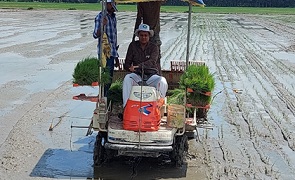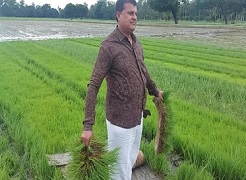The labor scarcity due to COVID-19 Pandemic has led to the popularization of mechanized methods of rice establishment in the various parts of the country. The Direct Seeded Rice (DSR) has gained popularity in Punjab and Haryana during the last two years. The initiative of KVK-CSISA Network shows the opportunity of scaling Machine Transplanting of Rice (MTR) for securing consistently higher paddy yield in the Eastern Indo-Gangetic Plains (EIGP). The shift from labor intensive activity to mechanization will play a crucial role in the rice-based ecosystem.
The same yield of rice and rice-wheat cropping system can be achieved in EIGP if agronomic management is at par with Punjab and Haryana. The KVK-CSISA Network has harnessed the best from Farmers’ Participatory Process (FPP) in the situations where land and water resources are at the command of farmers.


Shri Parmod Chaudhary, a farmer from Village Lazar Mahadeva, District Mahrajganj, Eastern Uttar Pradesh practiced MTR and Zero Tillage in Wheat (ZTW) under the supervision of KVK-CSISA Scientists from 2010-11. Due to labor scarcity after implementation of MNREGA, he bought the advanced version of South Korean Paddy Transplanter in 2010. The machine can transplant 8 to 10 Acres / day. The Machine transplanting was done in rows at 28 Cm apart during the 3rd week of June every year. For MTR, 12-18-day-old seedlings were transplanted with a 6-row self-riding type paddy transplanter (Dandong Self Propelled - Ride on Transplanter).
The nurseries for MTR were sown on dry beds with a recommended package of practice. During the last 8 years, continuously more tillers per plant and more yield in MTR were recorded. The successful results of this trial show that MTR is the best option to increase rice yield and MTR followed by ZTW is the best to increase the rice-wheat cropping system yield.
The technology allowed the farmers to manage time and intensification of the cropping system with less cost. The paddy yield and productivity growth has been flagged as an essential part for better agronomic management which can make the system more resilient and sustainable.
The average system yield of 12.0 t/ha has been achieved at the site. The technology has outperformed at the farm because of better quality South Korean Model which worked efficiently as compared to other models. Given the average yield of 6.9 t/ha at this farm and that of average of 3.4 t/ha from 6 Districts in Eastern Uttar Pradesh, there is a potential of sustained productivity growth of rice in these ecologies.
On another site of 70 Acres in village Kathotia in Sidharthnagar District, Shri Parmod has been practicing MTR since the last 8 years with the same yield potential. The plot was Laser Land Levelled first in 2010 and again in 2014. The land was fertilized with 150 Kg N as Urea and di-ammonium phosphate (DAP), 60 Kg P2O5 as DAP, 60 Kg K2O as Muriate of Potash (MOP) and 25 Kg ZnSO4 per hectare. The Medium duration rice variety - BPT-5204 was used by the farmer in combination with other management practices like irrigation, weed and nutrient from Kharif - 2011 to Kharif - 2019.
The Paddy yield ranged from 6 t/ha to 7.65 t/ha in six out of 8 years. Paddy yield of 5.73 t/ha in the Year - 2015 was due to attack of sheath blight and WBPH. So, it can be concluded that:
- There is a need to look beyond the existing model of top-down approach and work towards a bottom-up approach of innovating jointly with the farmers. This way, the extension and research are being carried out simultaneously.
- The paddy yields in EIGP ecologies can be at the same level to that of Punjab and Haryana with a focused attention on introducing best management practices as has been practiced in the use case.
(Source: KVK-CSISA Network)








Like on Facebook
Subscribe on Youtube
Follow on X X
Like on instagram